


xxxxxAs we have seen, in 1547 (E6) Ivan IV was crowned Tsar of All Russia. He at once set about reforming the country's administration - cutting the Boyars down to size - and by the mid-1550s he had seized control of the Volga River, gained access to the Caspian Sea, and opened up trade with England. From the early 1560s, however, he became mentally deranged, probably due to his deep-seated fear and mistrust of the Boyars. In 1565, he personally took over a vast area of crown land - the oprichnina - and then, using his 5000-strong bodyguard, slaughtered all the wealthy boyar families within that area, some 3000 in number. Other atrocities then followed, including the murder of his own son. Meanwhile, his foreign policy met with little success. An expedition did manage to cross the Ural Mountains, opening the way for the conquest of Siberia - the Pacific coast was eventually reached in 1639 (C1) - but in the north-west the Livonian War, waged by Russia to gain access to the Baltic Sea, ended in a crushing defeat for the Tsar's forces in 1582. When Ivan died in 1584, he was succeeded by his feeble-minded son Fyodor, but power rested with his regent and half-brother Boris Godunov. Considering the parlous state of the country, he did well to keep the nation together, as regent and then as Tsar, until his death in 1605.
IVAN IV "THE TERRIBLE" Ruled 1547 - 1584 (E6, M1, L1)
Acknowledgements
Ivan IV: detail, by the Russian painter Victor Vasnetsov (1848-1926), 1897 – Tretyakov Gallery, Moscow. Boyars: date and artist unknown. Timofeyevich: 18th century, artist unknown – Art Museum of Tomsk, Siberia, Russia. Map (Livonia): licensed under Creative Commons. Author: the Flemish cartographer Joannes Portantius, 1573 – en.wikipedia.org. First published in Theatrum Orbis Terrarum by the Flemish cartographer Abraham Ortelius (1527-1598). Godunov: 17th century, artist unknown. False Dmitry: date and artist unknown.
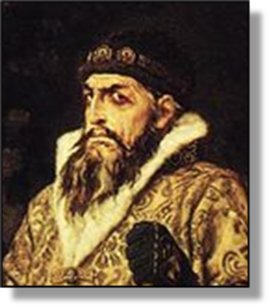 xxxxxBy the end of his reign in 1505, Ivan the Great, having thrown off Mongol domination, had united much of the diverse territory that made up European Russia. However, when his grandson, Ivan IV, came to the throne in 1533 he was just three years old. The inevitable happened. During his long minority the country was torn apart by a vicious struggle for power among the Boyars, the Russian aristocrats. Only turmoil reigned.
xxxxxBy the end of his reign in 1505, Ivan the Great, having thrown off Mongol domination, had united much of the diverse territory that made up European Russia. However, when his grandson, Ivan IV, came to the throne in 1533 he was just three years old. The inevitable happened. During his long minority the country was torn apart by a vicious struggle for power among the Boyars, the Russian aristocrats. Only turmoil reigned.
xxxxxAs we have seen, however, all this changed when, in 1547 (E6), at the age of 17, the young Ivan IV was crowned "Tsar and Grand Prince of All Russia". He quickly lived up to his impressive title, though the leading politicians at this time almost certainly played a major part, if not the major part in his undertakings. Anyway, as Tsar, he set about a thorough reform of the country's internal administration - cutting the Boyars down to size - and, at the same time, pushing the empire's boundaries further south. By 1556 he had conquered the Tatar Khanates of Kazan and Astrakhan and thus gained control of the Volga River and the trade routes to the Caspian Sea. At the same time, in 1554 he had opened up a lucrative trade with England following the visit to Moscow of the English navigator, Richard Chancellor. Indeed, during his first thirteen years in power, Ivan IV presided over one of the greatest periods of internal reform and external expansion in the history of Russia.
xxxxxBut it was not to last. Ivan was about to live up to his nickname. In 1560 his wife Anastasia, a member of the Romonov family, died suddenly. The marriage had been a happy one, and perhaps it was this personal tragedy that brought about the onset of some form of mental disorder, prone as he already was to violent fits of temper. Or was it the fact that at this very time his trusted and able field commander Prince Andrey Kurbsky defected to the Poles, blaming him for all the ills of Russia? More likely, it was his abiding fear and mistrust of the boyars, the hereditary nobility, that set him on a steep slope to a reign of terror. Whatever the underlying causes, convinced that his advisors, in collusion with the boyars, had caused his wife's death, and that he was himself in danger, he abandoned Moscow in December 1564 and settled in the village of Aleksandrovsk. He returned the following month, but only after it had been agreed by the Muscovites that he would have the right to exact punishment as he saw fit, and that he would be in personal control of an "oprichnina", a vast area of crown land comprising many wealthy towns and some of the best cultivated regions in Russia.
Including:
Tsar Boris
Godunov

L1-1558-1603-L1-1558-1603-L1-1558-1603-L1-1558-1603-L1-1558-1603-L1-1558-1603-L1
xxxxxOnce the oprichnina had been set up in 1565, his personal bodyguard - probably some 5,000 strong - then set about the systematic slaughter of the wealthy boyar families living within. Few survived. The number killed is difficult to estimate, but was almost certainly well above 3,000. Nor were the nobility the only target. One of his most savage atrocities was carried out in 1570 when, convinced on poor evidence that the people of Novgorod were planning to seek a union with Poland, he personally led his army in the attack. The town was virtually destroyed, and thousands of its inhabitants were massacred. Fortunately for those within the Tsar's "crown land", the oprichnina, the reign of terror only lasted seven years. In 1571 the Crimean Tatars, advancing deeply into the empire, sacked Moscow and almost wiped out its population, bringing to an end the idea of a separate and exclusive royal domain.
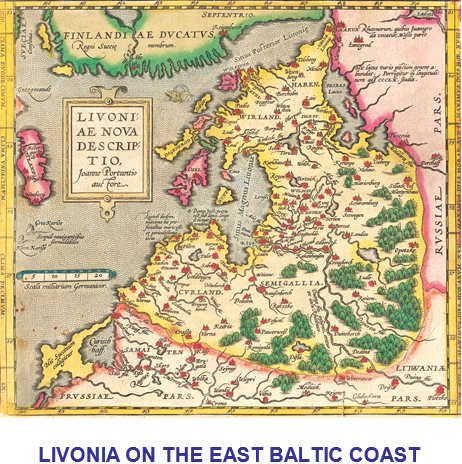 xxxxxAndxalongside this crazy, internal mayhem went an equally disastrous military policy. In attempting, unsuccessfully, to gain access to the Baltic Sea, Russian forces were engaged in the Livonian War, a bitter, fruitless struggle with Sweden and Lithuania which raged on with ever changing fortunes from 1557 to 1582. For a time Russia held Livonia, but with the entry into the war of Poland, led in 1576 by their king Stephen Bathory, the Tsar's forces were finally crushed in 1582. In this period of his reign, onlyxin the east were Russian forces successful, and this was not due to Ivan, but to the Cossack leader Yermak Timofeyevich. In 1581 he led an expedition of just 840 men across the Ural Mountains and, overrunning the Khanate of Sibir, brought most of the Ob River Basin under the empire's control, leaving the way open for the conquest of Siberia. As we shall see, the Russians eventually reached the Pacific Ocean in 1639 (C1).
xxxxxAndxalongside this crazy, internal mayhem went an equally disastrous military policy. In attempting, unsuccessfully, to gain access to the Baltic Sea, Russian forces were engaged in the Livonian War, a bitter, fruitless struggle with Sweden and Lithuania which raged on with ever changing fortunes from 1557 to 1582. For a time Russia held Livonia, but with the entry into the war of Poland, led in 1576 by their king Stephen Bathory, the Tsar's forces were finally crushed in 1582. In this period of his reign, onlyxin the east were Russian forces successful, and this was not due to Ivan, but to the Cossack leader Yermak Timofeyevich. In 1581 he led an expedition of just 840 men across the Ural Mountains and, overrunning the Khanate of Sibir, brought most of the Ob River Basin under the empire's control, leaving the way open for the conquest of Siberia. As we shall see, the Russians eventually reached the Pacific Ocean in 1639 (C1).
xxxxxBy the 1570s the Tsar had become mentally deranged, living a life that alternated between debauchery and total self denial. He remained dangerously unpredictable, and the killings continued. The climax came in 1581 when, in a fit of rage, he throttled his eldest and favourite son, Ivan. He died in 1584, a broken man, and his second son, the feeble-minded Fyodor, succeeded him amid relative calm. Beneath the surface, however, the country was tottering on the verge of political and economic collapse. With Fyodor's death in January 1598, his regent and half-brother Boris Godunov was elected Tsar, and for a while, as we shall see below, he managed to hold on to the reins of government before his own sudden death in 1605.
xxxxxIncidentally, we are told that the nickname "The Terrible" had nothing to do with his later acts of barbarity, but was given to him during his early campaign against the Tatars. His soldiers called him Grozny which, in Russian, means one who is dreaded or awe-inspiring. ...…
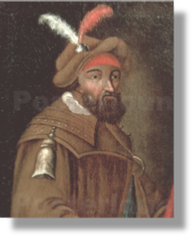
xxxxx...... Yermak Timofeyevich's exploits in western Siberia earned him a place in Russian folklore. His small force of men, having overthrown a much larger army (doubtless helped by the fact that they alone possessed firearms!), then seized the capital of Kashlyk (or Sibir) on the River Irtysh. In 1584, however, while leading a band of cossacks, he was attacked by Khan Kuchum, the leader of Sabir, and, while trying to escape, was drowned in the River Irtysh. The story goes that he could not swim because his coat of chain mail, a gift from the Tsar, was too heavy and took him under the water!
xxxxxAs we have seen, Boris Godunov (c1551-1605) became Tsar in 1598, though as regent to his feeble-minded brother Fyodor, he was virtual ruler of the country from 1584. A ruthless and autocratic leader, he managed to keep the country together, setting up a spy system to root out opposition, and banishing dissidents to Siberia, the first Tsar to do so. He reformed land tenure and taxation, and gave greater power and prestige to the Russian Orthodox Church, whilst in foreign policy he strengthened control over his Siberian territories and regained land lost earlier in the Gulf of Finland. But amongst the nobility and the peasantry there was growing discontent, and when a pretender to the throne marched into Russia in 1604 - claiming to be Dmitry, the dead son of Ivan IV - sides were drawn. In fact, the "False Dmitry" was easily crushed, but a few weeks later Godunov died suddenly, and the country - left with a vacant throne - was plunged into the so-called "Troubled Years", a period of chaos and anarchy which, as we shall see, did not end until the election of Michael, the first of the Romanov dynasty in 1613 (J1).
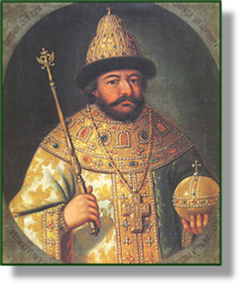 xxxxxAs we have seen, Boris Godunov (c1551-1605) became Tsar of Russia in 1598. He was born of a noble Tatar family, and began his career in the service of Ivan IV. He quickly gained the confidence of the Tsar and his standing was much further increased in 1580 when his sister, Irina, married Ivan's second son, the feeble-minded Fyodor. Following the death of the Tsar's eldest son Ivan (murdered by his father), Fyodor became heir to the throne and made Tsar on the death of his father in 1584. As regent and brother-in-law to the young and mentally-retarded Fyodor, Godunov became virtual ruler of Russia. Such was his status, that when Fyodor died in 1598, the national assembly (the zemsky sobor) voted him on to the throne, where he remained in power until 1605.
xxxxxAs we have seen, Boris Godunov (c1551-1605) became Tsar of Russia in 1598. He was born of a noble Tatar family, and began his career in the service of Ivan IV. He quickly gained the confidence of the Tsar and his standing was much further increased in 1580 when his sister, Irina, married Ivan's second son, the feeble-minded Fyodor. Following the death of the Tsar's eldest son Ivan (murdered by his father), Fyodor became heir to the throne and made Tsar on the death of his father in 1584. As regent and brother-in-law to the young and mentally-retarded Fyodor, Godunov became virtual ruler of Russia. Such was his status, that when Fyodor died in 1598, the national assembly (the zemsky sobor) voted him on to the throne, where he remained in power until 1605.
xxxxxGodunov was thus responsible for the government of Russia for over twenty years and, considering the state of the empire when he took it over, he did well to keep the country together. Ruthless and autocratic, he has the dubious distinction of being the first Tsar to use Siberia as a place of banishment for dissidents - in his case a group of boyars. At home, apart from reforming land tenure and taxation, he built up the country's defences, legalised serfdom, and set up a spy system to root out any opposition. He also took the important step of elevating the Russian Orthodox Church to the rank of a patriarch, giving it greater power and prestige. In foreign policy he did well. He strengthened Russian control over the newly conquered lands of Siberia, and, in a short campaign, regained land in the Gulf of Finland which had earlier been lost to Sweden.
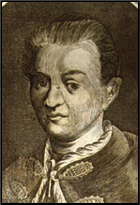 xxxxxBut many of these measures put him at odds with the nobility, whilst, at the other end of the social scale, his inability to alleviate the suffering caused by widespread famine stirred up popular opposition throughout the country. Onlyxa spark was needed to blow the country apart and this came in the form of a pretender to the throne, the so called False Dmitry (here illustrated). A de-frocked monk, he claimed to be Dmitry, younger son of the late Tsar, who had actually died, somewhat mysteriously, in 1591. Appearing in Poland in 1603, he gained the support of the Poles, and then in 1604 marched into Russia at the head of an army of Cossacks (serfs who had escaped and were following a nomadic life), and a disparate following of adventurers. This invading force was given a welcome by some of the populace, but it was not a real threat and the imperial troops easily defeated it. However, a few weeks later Godunov was suddenly taken ill and died. The throne was vacant, and Russia was now in for what is euphemistically called "The Troubled Years". As we shall see, this period of chaos, - which included brief reigns by Fyodor, son of Godunov, and the False Dmitry - was not to be ended until the election of Michael, the first of the Romanov dynasty in 1613 (J1).
xxxxxBut many of these measures put him at odds with the nobility, whilst, at the other end of the social scale, his inability to alleviate the suffering caused by widespread famine stirred up popular opposition throughout the country. Onlyxa spark was needed to blow the country apart and this came in the form of a pretender to the throne, the so called False Dmitry (here illustrated). A de-frocked monk, he claimed to be Dmitry, younger son of the late Tsar, who had actually died, somewhat mysteriously, in 1591. Appearing in Poland in 1603, he gained the support of the Poles, and then in 1604 marched into Russia at the head of an army of Cossacks (serfs who had escaped and were following a nomadic life), and a disparate following of adventurers. This invading force was given a welcome by some of the populace, but it was not a real threat and the imperial troops easily defeated it. However, a few weeks later Godunov was suddenly taken ill and died. The throne was vacant, and Russia was now in for what is euphemistically called "The Troubled Years". As we shall see, this period of chaos, - which included brief reigns by Fyodor, son of Godunov, and the False Dmitry - was not to be ended until the election of Michael, the first of the Romanov dynasty in 1613 (J1).
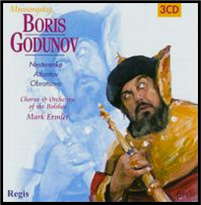
xxxxxIncidentally, in 1825 the Russian poet and playwright Alexander Pushkin wrote one of his best known plays, Boris Godunov, based on the Tsar. In this tragedy, mainly in blank verse, he makes Godunov guilty of the murder of the young crown prince, Dmitry, thus adding considerably to the drama of the situation. Some years later his countryman, the composer Modest Mussorgsky, produced an opera partly based on this play. It was first performed in St. Petersburg in 1874.







 xxxxxBy the end of his reign in 1505, Ivan the Great, having thrown off Mongol domination, had united much of the diverse territory that made up European Russia. However, when his grandson, Ivan IV, came to the throne in 1533 he was just three years old. The inevitable happened. During his long minority the country was torn apart by a vicious struggle for power among the Boyars, the Russian aristocrats. Only turmoil reigned.
xxxxxBy the end of his reign in 1505, Ivan the Great, having thrown off Mongol domination, had united much of the diverse territory that made up European Russia. However, when his grandson, Ivan IV, came to the throne in 1533 he was just three years old. The inevitable happened. During his long minority the country was torn apart by a vicious struggle for power among the Boyars, the Russian aristocrats. Only turmoil reigned. 
 xxxxxAndxalongside this crazy, internal mayhem went an equally disastrous military policy. In attempting, unsuccessfully, to gain access to the Baltic Sea, Russian forces were engaged in the Livonian War, a bitter, fruitless struggle with Sweden and Lithuania which raged on with ever changing fortunes from 1557 to 1582. For a time Russia held Livonia, but with the entry into the war of Poland, led in 1576 by their king Stephen Bathory, the Tsar's forces were finally crushed in 1582. In this period of his reign, onlyxin the east were Russian forces successful, and this was not due to Ivan, but to the Cossack leader Yermak Timofeyevich. In 1581 he led an expedition of just 840 men across the Ural Mountains and, overrunning the Khanate of Sibir, brought most of the Ob River Basin under the empire's control, leaving the way open for the conquest of Siberia. As we shall see, the Russians eventually reached the Pacific Ocean in 1639 (C1).
xxxxxAndxalongside this crazy, internal mayhem went an equally disastrous military policy. In attempting, unsuccessfully, to gain access to the Baltic Sea, Russian forces were engaged in the Livonian War, a bitter, fruitless struggle with Sweden and Lithuania which raged on with ever changing fortunes from 1557 to 1582. For a time Russia held Livonia, but with the entry into the war of Poland, led in 1576 by their king Stephen Bathory, the Tsar's forces were finally crushed in 1582. In this period of his reign, onlyxin the east were Russian forces successful, and this was not due to Ivan, but to the Cossack leader Yermak Timofeyevich. In 1581 he led an expedition of just 840 men across the Ural Mountains and, overrunning the Khanate of Sibir, brought most of the Ob River Basin under the empire's control, leaving the way open for the conquest of Siberia. As we shall see, the Russians eventually reached the Pacific Ocean in 1639 (C1). 
 xxxxxAs we have seen, Boris Godunov (c1551-
xxxxxAs we have seen, Boris Godunov (c1551- xxxxxBut many of these measures put him at odds with the nobility, whilst, at the other end of the social scale, his inability to alleviate the suffering caused by widespread famine stirred up popular opposition throughout the country. Onlyxa spark was needed to blow the country apart and this came in the form of a pretender to the throne, the so called False Dmitry (here illustrated). A de-
xxxxxBut many of these measures put him at odds with the nobility, whilst, at the other end of the social scale, his inability to alleviate the suffering caused by widespread famine stirred up popular opposition throughout the country. Onlyxa spark was needed to blow the country apart and this came in the form of a pretender to the throne, the so called False Dmitry (here illustrated). A de-



